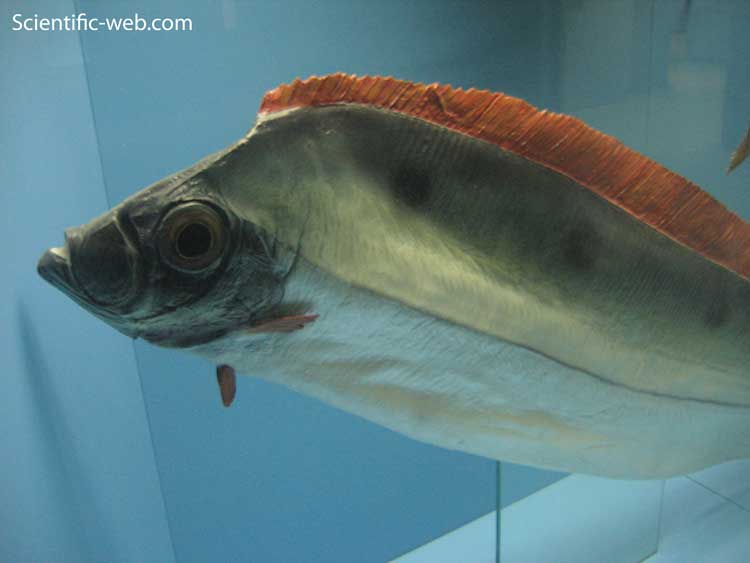
Deal fish, Trachipterus arcticus (Brünnich, 1771), Photo: Michael Lahanas
Superregnum : Eukaryota
Cladus: Unikonta
Cladus: Opisthokonta
Cladus: Holozoa
Regnum: Animalia
Subregnum: Eumetazoa
Cladus: Bilateria
Cladus: Nephrozoa
Superphylum: Deuterostomia
Phylum: Chordata
Subphylum: Vertebrata
Infraphylum: Gnathostomata
Megaclassis: Osteichthyes
Superclassis/Classis: Actinopterygii
Classis/Subclassis: Actinopteri
Subclassis/Infraclassis: Neopterygii
Infraclassis: Teleostei
Megacohors: Osteoglossocephalai
Supercohors: Clupeocephala
Cohors: Euteleosteomorpha
Subcohors: Neoteleostei
Infracohors: Eurypterygia
Sectio: Ctenosquamata
Subsectio: Acanthomorphata
Divisio: Lampripterygii
Superordo: Lampridiomorpha
Ordo: Lampridiformes
Familia: Trachipteridae
Genus: Trachipterus
Species: T. arcticus
Trachipterus arcticus is a species of ribbonfish found predominantly in the North Atlantic Ocean, with one report from the Mediterranean Sea.[2] They are rarely encountered by humans due to their deep-sea habitat and the fact that they are of no commercial value. This species is commonly referred to as the dealfish to differentiate it from the nine other ribbonfish species in the family Trachipteridae.
Appearance
Dealfish have a long, slender eel-like body. They are a bright silver in colour, often with faint black spots along the flanks and the pink dorsal fin runs the full length of the body. The tail is very small and the underside is free of pectoral or pelvic fins. The maximum size of this species is thought to be 8–9 feet in length, although they are typically around half of this size.[3]
Distribution and habitat
Dealfish are mostly found in the North Atlantic Ocean from Norway and Iceland to Madeira Islands. They are also present in the North Sea and in the Mediterranean Sea (one record). They are also found off along the coast of the United States of America (which is also possibly a separate species).[2] Dealfish are generally found far out to sea and far away from land masses in waters of around 300 to 1000 metres deep. While they are found in deep water they do not live or feed on the seabed and instead live in the pelagic (mid-water) zone.[3] Dealfish are thought to feed predominately by hunting small fish and squid.[4]
Life cycle
The life cycle and behaviour of the dealfish is relatively poorly understood. They are thought to spend most of their life as a solitary creature, but form into large shoals/groups from time to time.[3] It is currently unknown whether this is done for feeding, spawning or some other purpose.[2] Dealfish are not recognised as a food fish anywhere in the world, and are of no interest at all to commercial fisheries, with any dealfish caught by commercial vessels usually being discarded at sea. Due to being a deep-water species dealfish are rarely encountered by humans.[3] However, dealfish do wash up on beaches from time to time, although it is unknown why this is the case.[5]
Second species of dealfish
There is evidence that dealfish should be divided into two separate species, as dealfish found in the Northern and Western Atlantic show some genetic differences.[6]
References
Moore, J. (2019). "Trachipterus arcticus". IUCN Red List of Threatened Species. 2019: e.T18127641A21931000. doi:10.2305/IUCN.UK.2019-2.RLTS.T18127641A21931000.en. Retrieved 19 November 2021.
Froese, Rainer; Pauly, Daniel (eds.) (2014). "Trachipterus arcticus" in FishBase. April 2014 version.
"Dealfish". BritishSeaFishing.co.uk. 2 May 2014.
"Trachipterus arcticus". Species Identification.org. 2 May 2014.
"Fish Find is a Big 'Deal'". Donegal Now. 29 May 2012.
Robins, CR, Ray GC (1986). A field guide to Atlantic coast fishes of North America. Houghton Mifflin. pp. 354.
Retrieved from "http://en.wikipedia.org/"
All text is available under the terms of the GNU Free Documentation License

